 |
 |
Our enthusiastic and extremely knowledgeable perennials team is here to answer your questions and help you choose the best perennials for your situation. There’s always something in bloom for sun, shade, butterflies, birds or deer resistance as well as a variety of bulbs for your space.
Stroll through our time-tested favorites and introduce yourself to the newest varieties. We garden with perennials too; we love them and it shows!
|
29 found, showing page 2 of 2
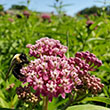
This monarch host plant produces pink blooms summer through fall. Requires moist soils. Self-seeder. Native. USDA 3-6
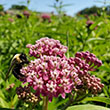
Plant Height: 3 feet
Flower Height: 4 feet
Spread: 32 inches
Sunlight: full sun partial shade
Hardiness Zone: 2a
Other Names: Butterfly Weed
Description:
A wonderful selection for attracting butterflies to garden beds and rain gardens; this upright selection features clusters of rosy-pink, fragrant flowers and green narrow foliage; a compact variety that is easy to grow, needing little to no maintenance
Ornamental Features:
Swamp Milkweed has fuchsia flat-top flowers with rose overtones at the ends of the stems from mid summer to early fall. The flowers are excellent for cutting. Its narrow leaves remain grayish green in color throughout the season.
Landscape Attributes:
Swamp Milkweed is an herbaceous perennial with an upright spreading habit of growth. Its medium texture blends into the garden, but can always be balanced by a couple of finer or coarser plants for an effective composition.
This is a relatively low maintenance plant, and is best cleaned up in early spring before it resumes active growth for the season. It is a good choice for attracting butterflies to your yard, but is not particularly attractive to deer who tend to leave it alone in favor of tastier treats. It has no significant negative characteristics.
Swamp Milkweed is recommended for the following landscape applications:
- Mass Planting
- General Garden Use
- Naturalizing And Woodland Gardens
- Bog Gardens
Planting & Growing:
Swamp Milkweed will grow to be about 3 feet tall at maturity extending to 4 feet tall with the flowers, with a spread of 32 inches. It tends to be leggy, with a typical clearance of 1 foot from the ground, and should be underplanted with lower-growing perennials. It grows at a medium rate, and under ideal conditions can be expected to live for approximately 10 years. As an herbaceous perennial, this plant will usually die back to the crown each winter, and will regrow from the base each spring. Be careful not to disturb the crown in late winter when it may not be readily seen!
This plant does best in full sun to partial shade. It is quite adaptable, prefering to grow in average to wet conditions, and will even tolerate some standing water. It is not particular as to soil type or pH. It is quite intolerant of urban pollution, therefore inner city or urban streetside plantings are best avoided. This species is native to parts of North America.

Ruffled petals with sunset pink and coral tones. Black walnut tolerant. USDA 3-9
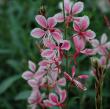
Rose pink blooms on rigid stems. Naturalizing. USDA 5-8 'Siskiyou Pink' prefers full sun and is happy in average to poor, well-drained soil. Wandflower is a tap-rooted perennial so it is very drought tolerant. The tap root makes these difficult to move once they are settled in, so site them carefully.
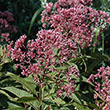
Pink blooms. Tolerates clay & wet soils. Native cultivar. Naturalizing. USDA 4-8
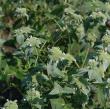
PYCNANTHEMUM MUTICUM 1 Gallon | Mountain Mint | Pink blooms. Fragrant silvery foliage. Naturalizing. Native. USDA 4-8
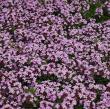
Pink blooms. Fragrant foliage. Evergreen. Moderate foot traffic. USDA 5-8
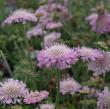
Pale-pink blooms. Long blooming. Compact. Clump-forming. USDA 5-9
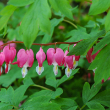
Height: 3 feet
Spacing: 30 inches
Sunlight: partial shade full shade
Hardiness Zone: 1b
Other Names: Old Fashioned Bleeding Heart
Description:
Bushy upright mounded selection features blue-green fern-like foliage and arching stems of heart shaped locket flowers with white protruding petals; excellent for shaded borders and beds; beautiful cut flower; goes into summer dormancy
Ornamental Features:
Common Bleeding Heart features delicate nodding pink heart-shaped flowers with white tips dangling from the stems from late spring to early summer. Its ferny compound leaves remain bluish-green in color throughout the season.
Landscape Attributes:
Common Bleeding Heart is an herbaceous perennial with a mounded form. Its relatively fine texture sets it apart from other garden plants with less refined foliage.
This plant will require occasional maintenance and upkeep, and should be cut back in late fall in preparation for winter. It is a good choice for attracting butterflies to your yard, but is not particularly attractive to deer who tend to leave it alone in favor of tastier treats. It has no significant negative characteristics.
Common Bleeding Heart is recommended for the following landscape applications:
- Mass Planting
- General Garden Use
- Planting & Growing
Common Bleeding Heart will grow to be about 3 feet tall at maturity, with a spread of 3 feet. When grown in masses or used as a bedding plant, individual plants should be spaced approximately 30 inches apart. It grows at a medium rate, and under ideal conditions can be expected to live for approximately 15 years. As an herbaceous perennial, this plant will usually die back to the crown each winter, and will regrow from the base each spring. Be careful not to disturb the crown in late winter when it may not be readily seen! As this plant tends to go dormant in summer, it is best interplanted with late-season bloomers to hide the dying foliage.
This plant does best in partial shade to shade. It prefers to grow in average to moist conditions, and shouldn't be allowed to dry out. It is not particular as to soil pH, but grows best in rich soils. It is somewhat tolerant of urban pollution. Consider applying a thick mulch around the root zone over the growing season to conserve soil moisture. This species is not originally from North America. It can be propagated by division.

Height: 22 inches
Spacing: 18 inches
Sunlight: partial shade, full shade
Hardiness Zone: 4a
Other Names: Lenten Rose, Winter Rose
Group/Class: Honeymoon Series
Brand: Proven Winners
Description:
This attractive variety produces bushy mounds of thick evergreen leaves; flower stalks bear showy, cup shaped blooms in shades of pink with purple edges; a great selection for shade gardens
Ornamental Features:
Honeymoon Paris In Pink Hellebore features showy nodding pink cup-shaped flowers with purple edges at the ends of the stems from late winter to early spring. Its attractive serrated oval compound leaves remain dark green in color throughout the year.
Landscape Attributes:
Honeymoon Paris In Pink Hellebore is an herbaceous evergreen perennial with an upright spreading habit of growth. Its medium texture blends into the garden, but can always be balanced by a couple of finer or coarser plants for an effective composition.
This is a relatively low maintenance plant, and should be cut back in late fall in preparation for winter. Deer don't particularly care for this plant and will usually leave it alone in favor of tastier treats. It has no significant negative characteristics.
Honeymoon Paris In Pink Hellebore is recommended for the following landscape applications:
- Mass Planting
- Rock/Alpine Gardens
- Border Edging
- General Garden Use
- Naturalizing And Woodland Gardens
Planting & Growing:
Honeymoon Paris In Pink Hellebore will grow to be about 18 inches tall at maturity, with a spread of 24 inches. When grown in masses or used as a bedding plant, individual plants should be spaced approximately 18 inches apart. Its foliage tends to remain dense right to the ground, not requiring facer plants in front. It grows at a medium rate, and under ideal conditions can be expected to live for approximately 5 years. As an evegreen perennial, this plant will typically keep its form and foliage year-round.
This plant does best in partial shade to shade. It does best in average to evenly moist conditions, but will not tolerate standing water. It is not particular as to soil pH, but grows best in rich soils. It is somewhat tolerant of urban pollution, and will benefit from being planted in a relatively sheltered location. This particular variety is an interspecific hybrid, and parts of it are known to be toxic to humans and animals, so care should be exercised in planting it around children and pets. It can be propagated by division; however, as a cultivated variety, be aware that it may be subject to certain restrictions or prohibitions on propagation.
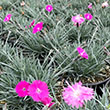
Fragrant pink blooms. Tufted, Mounded habit. USDA: 3-8
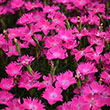
Fragrant rose-pink blooms. Long blooming. Upright clumping. USDA 4-8
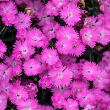
Plant Height: 6 inches
Flower Height: 8 inches
Spacing: 8 inches
Sunlight: full sun
Hardiness Zone: 3a
Other Names: Cheddar Pinks, Clove Pinks
Description:
A robust variety bearing single, fuchsia flowers in late spring to early summer, over a cushion of blue-green, grass-like leaves; has a mild, clove-like, spicy fragrance; will sporadically re-bloom throughout the summer
Ornamental Features:
Firewitch Pinks has masses of beautiful fragrant fuchsia frilly flowers with white eyes at the ends of the stems from late spring to mid summer, which are most effective when planted in groupings. The flowers are excellent for cutting. Its attractive grassy leaves remain silvery blue in color throughout the year.
Landscape Attributes:
Firewitch Pinks is an herbaceous evergreen perennial with a mounded form. It brings an extremely fine and delicate texture to the garden composition and should be used to full effect.
This plant will require occasional maintenance and upkeep, and is best cleaned up in early spring before it resumes active growth for the season. It is a good choice for attracting bees and butterflies to your yard, but is not particularly attractive to deer who tend to leave it alone in favor of tastier treats. It has no significant negative characteristics.
Firewitch Pinks is recommended for the following landscape applications:
- Mass Planting
- Rock/Alpine Gardens
- Border Edging
- General Garden Use
- Container Planting
- Planting & Growing
Firewitch Pinks will grow to be only 6 inches tall at maturity extending to 8 inches tall with the flowers, with a spread of 10 inches. When grown in masses or used as a bedding plant, individual plants should be spaced approximately 8 inches apart. Its foliage tends to remain low and dense right to the ground. It grows at a medium rate, and under ideal conditions can be expected to live for approximately 5 years. As an evegreen perennial, this plant will typically keep its form and foliage year-round.
This plant should only be grown in full sunlight. It prefers to grow in average to moist conditions, and shouldn't be allowed to dry out. It is not particular as to soil type or pH. It is highly tolerant of urban pollution and will even thrive in inner city environments. This is a selected variety of a species not originally from North America. It can be propagated by cuttings; however, as a cultivated variety, be aware that it may be subject to certain restrictions or prohibitions on propagation.
Firewitch Pinks is a fine choice for the garden, but it is also a good selection for planting in outdoor pots and containers. It is often used as a 'filler' in the 'spiller-thriller-filler' container combination, providing a mass of flowers and foliage against which the thriller plants stand out. Note that when growing plants in outdoor containers and baskets, they may require more frequent waterings than they would in the yard or garden.
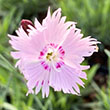
Clusters of pink, fringed flowers cover the entire plant in the summer. Cold hardy. Long bloom cycle. USDA 3-9
29 found, showing page 2 of 2










